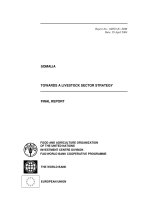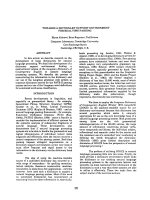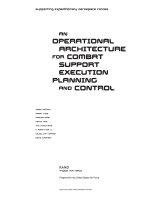TOWARDS a FEDERATIVE POLYGLOT ARCHITECTURE FOR MANAGING SMART GRID DATA
Bạn đang xem bản rút gọn của tài liệu. Xem và tải ngay bản đầy đủ của tài liệu tại đây (1.14 MB, 24 trang )
TOWARDS A FEDERATIVE
POLYGLOT ARCHITECTURE
FOR MANAGING SMART GRID DATA
Presented by: NHU QUYNH NGUYEN
20112648 – SIC PFIEV 56
Supervisor:
Professor Christine Collet
Professor Christophe Bobineau
Professor Binh Minh Nguyen
Postdoctoral Researcher Houssem Chihoub
Performed at:
Grenoble Computer Science Laboratory (LIG)
HADAS Team
1
Outline
I. Introduction
II. Polyglot Solution
1. Overview of architecture
2. Data layer
III. Architecture Implementation et Preliminary
Performance Evaluation
1. Data layer implementation
2. Benchmarking queries
IV. Conclusion and Future work
2
I. Introduction: What is the Smart Grid?
Many Definitions – But One VISION
- Engaging Consumers
- Enhancing Efficiency
- Ensuring Reliability
- Enabling Renewables & Electric
Transportation
3
I. Introduction: Data Management Challenge in
Smart Grid (1)
The Electricity Consumption Information
Collection System of the Grid
Collector
RDBMS
•
In France ERDF is planning to deploy 35 million smart meters by the year
2021
•
Smart meter readings every 15 minutes => 96 million reads per day for
every million meters => 3000-fold increase in data
4
I. Introduction: Data Management Challenge in
Smart Grid (2)
• Five separate classes of smart grid data, each with
its own unique characteristics
5
I. Introduction: Data Management Challenge in
Smart Grid (3)
• Taking long time to perform a data analysis
• Mismatch between the database model and the
programming model
• Difficult to modify a relational schema
6
• Increasing the amount of data
II. Polyglot Solution: Concept
Using multiple data storage technologies for
an individual application
Chosen based upon the best way data can be
stored and retrieved for the application
Application
7
II. Polyglot Solution: Architecture of proposed system
8
II. Polyglot Solution: Data layer (1)
Meter
Data
Weather
Data
Geographic
Data
9
II. Polyglot Solution: Data layer (2)
Why using PostgreSQL for Client data?
• Client data stores contact details of customers
such as first name, last name, address..
• Client data requires concurrency control
strategies, data uniqueness, data security and
read-only access
• A relational database provides more control and
guarantees over data
• PostgreSQL is powerful, a open source objectrelational database system
• PostgreSQL supports CSV file, more reliability,
can run in Linux, BSD, Windows…
10
II. Polyglot Solution: Data layer (3)
Why using Cassandra for Meter data
• Meter data stores measurements of customers
are recorded by smart meters, time series data
• Data arrives from many locations, requires read
and write scalability
• Cassandra is an excellent fit for handling data in
sequence regardless of datatype or size
• Cassandra is highly performant with tables
that have thousands of columns
11
II. Polyglot Solution: Data layer (4)
Why using MongoDB for Weather and Geographic data
• Geographic data: stores location of smart meters,
geospatial queries, simple model
• Weather data: stores weather conditions such as wind
speed, dry bulb temperature…
• MongoDB: provides scale-out capabilities along with
smoother and faster data access
• Indexing is needed in
this use case in order
to efficiently perform
geospatial queries
12
III. Architecture Implementation: Technologies
Spring framework: Java platform that provides
comprehensive infrastructure support for developing Java
applications
Apache Maven: a software project management and
comprehension tool based on the concept of a project
object model (POM)
RESTful API: REpresentational State Transfer architecture
based web services and uses HTTP Protocol for data
communication.
13
III. Architecture Implementation: Data layer (1)
Client data modeling and loading
14
III. Architecture Implementation: Data layer (2)
Configuration PostgreSQL
15
Architecture Implementation: Data layer (3)
Meter data modeling and loading
16
III. Architecture Implementation: Data layer (4)
Configuration Cassandra
17
III. Architecture Implementation: Data layer (5)
Geographic and Weather data modeling and
loading
18
III. Architecture Implementation: Data layer (6)
Configuring MongoDB
19
III. Architecture Implementation: Benchmarking
Queries (1)
Query 1: Search highest electricity consuming
measured by smart meter of client that have
registered a specific address in the city of Lyon
20
III. Architecture Implementation: Benchmarking
Queries (2)
Query 2: Calculate the total amount of electricity
consumption by clients in Lyon at minimum
temperature below than an input temperature.
21
III. Architecture Implementation: Benchmarking
Queries (3)
Query 3: Calculate the electric bill using during one
month of electricity consumption based on a specific
meter ID of client
22
IV. Conclusion and Future work
•
•
Conclusion:
Research on a new solution designed for management
and storage data with high-performance – Polyglot
solution
Deployment an architecture platform and a data
model simulation for Smart Grid management system
Future mission:
•
Performance comparison with traditional architecture
•
Increasing complexity of the query
23
24









